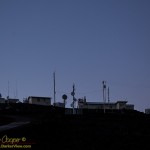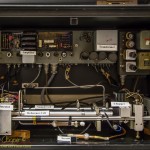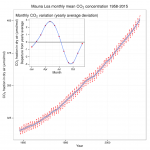Scientific instruments have a habit of presenting us with uncomfortable truths. Galileo’s telescopes showed that our solar system did not conform to the prevailing teachings of the day. The great particle accelerators show a complexity underlying reality that defies a simple explanation of the universe. Likewise an almost forgotten instrument sitting atop a volcano has shown that humans have altered our world in very damaging ways.

It was in the main building that we stopped to look at a little instrument parked rather oddly in the hall. Not much, a simple box with a few aluminum tubes and a bit of circuitry and wiring. It took me a moment to realize I was looking at a piece of scientific history. Here was the Scripps Carbon Dioxide Analyzer that has provided the data that has changed our relationship with our planet.
This little instrument is an infrared carbon dioxide analyzer that was built by Applied Physics Co. and installed by Charles Keeling. Here, atop a volcano in the middle of the Pacific it was possible to get an unprecedented, clean sample of our planet’s atmosphere. For decades this instrument operated, telling a story of change. Measuring the result of a civilization powered by carbon based fuels, oil and coal, and what that has done to the atmosphere.

The carbon dioxide analyzer is no longer in service, it was retired in favor of more accurate instruments in 2006 after 48 years in service. An incredible run for a scientific instrument of this type. The analyzer sits as sort of a museum piece along the main hallway of the lab, unknown to any but those few who visit the remote site atop Mauna Loa. Someone has put some small labels on the parts, otherwise this historic instrument sits almost forgotten.
Two sample chambers are used, one with a reference mix of known gas, the other with a sample of the atmosphere drawn down a tube from a tower above the lab. By measuring the response of both tubes and comparing the ratio one can see the concentration of carbon dioxide in the air. The readout is a paper chart recorder, typical technology for 1958. Each day someone would have to take the chart and painstakingly transcribe the numbers into the records, in later years enter the data into a computer for analysis.

Plot atmospheric carbon dioxide concentration alongside global temperature and the story becomes more concerning. Combined with what we know about the greenhouse effect, about the absorption of infrared light by carbon dioxide, we realize there is more energy coming from sunlight absorbed by the planet than before. The Earth is warming, and our carbon dioxide emissions are the cause. Oddly, it is the absorption of infrared light by carbon dioxide gas that is the principle by which the Mauna Loa gas analyzer works.
There’s still no explanation and no one can tell me yet what percentage of so-called climate change is due to human activity, what percentage is due to natural trends, natural cycles – Lamar Smith, chairman of the House Committee on Science, Space and Technology
The numbers are inarguable, but many still insist on doing so. The data is fabricated, or misinterpreted insist all too many. For many reasons people will not accept the findings of our climate scientists. For many it is simply that accepting the science would mean admitting that the technology that makes our lives so comfortable has come at a price. That fixing the problem may involve accepting uncomfortable changes to our lives.
It is not just one data set that tells the story. While Keeling’s gas analyzer atop Mauna Loa started our change in understanding, it is just part of the story, the first chapter. It was the data that alerted us to something that me might want to pay closer attention to. Slowly the attention of an entire scientific community was drawn to studying the problem. The findings have been confirmed dozens upon dozens of times. The effects of climate change have become visible all over our world. Maybe we can do something about it?


The measurements of CO2 levels are one of the few certain parameters in the AGW case.
Nobody argues that CO2 absorption directly poses a threat but rather it is the subsequent feedback loops and forcings namely water vapor which supposedly drive the warming.
These initial aphysical estimates are now known to be wrong
:
http://www.scientificamerican.com/article/climate-change-will-not-be-dangerous-for-a-long-time/
Giving the public the impression that models involving coupled nonlinear equations with aphysical fudge factors are beyond question is the most grotesque scientism since Trofim Lysenko.
And since Energy is the lifeblood of civilization, the stakes in human lives are comparable to Lysenko’s genocide.
And is the West doing ? Shutting down reactors and pushing ethanol and wind and solar all of which are known to be abject failures from a simple back of the envelope calculation.
Giving politicians more power and money will only result in more boondoggles such as the ethanol fiasco…..but indeed this is the proposed solution to AGW.
I agree that the models vary quite widely in estimating the effects. But there is no reasonable doubt that the planet is warming and that CO2 from fossil fuels is a major driver of that warming. Reduction of CO2 emissions is a reasonable goal and the increased use of renewable energy sources is a good move.
Comparisons to Lysenko are a bit unfair and more than a little extreme. The evidence is quite strong here and not something you need to take on faith. Coming to terms with the problem and not causing widespread misery through action or inaction is the challenge. Have not yet digested the full implications of the Paris agreements, wondering if there has been a step in the right direction.
I’m sticking with the Latter Day Lysenkoists, Branch Carbinian description.
Take ethanol. No sane person believes turning hydrocarbons into carbohydrates and then back into hydrocarbons is an efficient process. All this does is increase carbon emissions and starve the world’s poor…..and enrich politicians and their cronies.
Now the 1st World is demanding the developing world use inferior energy technology. This reminds me of the millions of preventable deaths that resulted in the developing world when we bribed their politicians to discontinue the use of DDT to combat malaria. We are proposing the same scheme today. Bribes to their politicians in exchange for harming their own populations. The Mugabe’s of the world are more than happy to pocket the money and then buy “alternatives” from the Congressman’s district who secured the bribes. Same reason we are sending tanks to the Egyptians even if they don’t want or need them.
I’d challenge you to name a greater peacetime propaganda push than the barrage of AGW hysteria that has been directed at the public in the last 10 years.
If C02 were being taken seriously, we would be building reactors, not fermenting corn and shipping the ethanol to Hawaii for fuel.